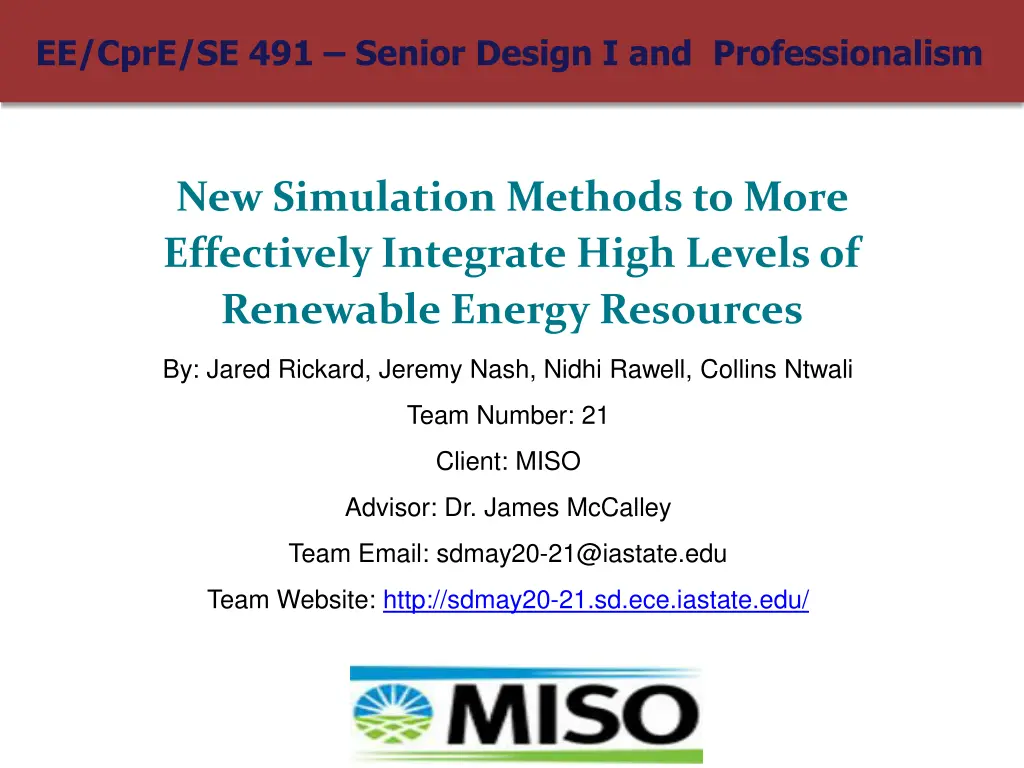
New Simulation Methods for Efficient Renewable Energy Integration
Explore innovative simulation methods to efficiently integrate high levels of renewable energy resources while reducing data fidelity, maintaining key production cost information, and improving simulation runtime. This senior design project aims to create a software tool that clusters profile data to enhance analysis and decision-making for energy systems.
Download Presentation

Please find below an Image/Link to download the presentation.
The content on the website is provided AS IS for your information and personal use only. It may not be sold, licensed, or shared on other websites without obtaining consent from the author. If you encounter any issues during the download, it is possible that the publisher has removed the file from their server.
You are allowed to download the files provided on this website for personal or commercial use, subject to the condition that they are used lawfully. All files are the property of their respective owners.
The content on the website is provided AS IS for your information and personal use only. It may not be sold, licensed, or shared on other websites without obtaining consent from the author.
E N D
Presentation Transcript
EE/CprE/SE 491 Senior Design I and Professionalism New Simulation Methods to More Effectively Integrate High Levels of Renewable Energy Resources By: Jared Rickard, Jeremy Nash, Nidhi Rawell, Collins Ntwali Team Number: 21 Client: MISO Advisor: Dr. James McCalley Team Email: sdmay20-21@iastate.edu Team Website: http://sdmay20-21.sd.ece.iastate.edu/
Problem Statement To research and implement various methods to appropriately reduce the fidelity of data profiles while maintaining an adequate amount of key production cost information. The study must validate the methods reliability and quantify the effects the profile approximation has on simulation runtime and results. It is expected that the properly designed profile reduction method would make the normal 8760 hours production cost simulation more efficient. MISO & ISU Final Presentation.2 EE 491 (Senior Design - Team 21)
ConceptualSketch Develop a software tool that computes different metrics of profile data and clusters the data into representative profiles based on those metrics. Develop Run PCM simulations of the approximated and un-approximated data and compare the results. Run Refine Refine what metrics are used to cluster data and then run new simulations. Document Document what was tested to refine these metrics in a report for our client Package Finally package all these different options into a UI that our client can use. MISO & ISU Final Presentation.3 EE 491 (Senior Design - Team 21)
Functional Requirements 1. Python script to find approximate data sets Data subset returned should be quantitatively "close" to original set. 2. Methods reliability PCM simulation of this data subset must reliably forecast key PCM information of an un-approximated profile. 3. Total computation time Reduce PCM simulations from ~72 hours to under 24 hours 4. Easy to use User-Interface Tool design should be easy for an untrained user to test and use. MISO & ISU Final Presentation.4 EE 491 (Senior Design - Team 21)
Non-functional Requirements 1. Code Convention Readability - Clearly commented and labelled for easy modification Modifiability Modularized for easy upgrades and maintenance. Simplicity - Efficient; omit unnecessary functions 2. Tool Usability Short process/steps Fast runtime User manual 3. Results Reproducible testing List of best metrics MISO & ISU Final Presentation.5 EE 491 (Senior Design - Team 21)
Potential Risks & Mitigation 1. Limited knowledge in coding, data manipulation, and UI design Practice and research what works. 2. Limited knowledge of power grid data attributes and how to characterize the power grid. Communicate with the client about what they would like to see Research what others in the field might consider important 3. Obtaining the software necessary Stay in constant communication with the production cost modeling software developer MISO & ISU Final Presentation.6 EE 491 (Senior Design - Team 21)
Resource/Cost Estimate 1. Resources IDEs to write Python Production cost modeling simulation software Remote virtual machines to run simulation software 2. Cost Python and related IDEs are free We're receiving the simulation software for free on a research license Virtual machines have been provided by the ETG for free Currently zero cost MISO & ISU Final Presentation.7 EE 491 (Senior Design - Team 21)
Project Milestones 1. Complete function to subdivide data profiles Evaluated by reviewing code and possibly hand computing test samples 2. Complete function that clusters data Evaluated by reviewing code and trying simple, one-dimensional sample clusters 3. Run multiple PCM simulations with different approximated data sets Evaluated by comparing to results of un-approximated data set 4. Complete UI Evaluated by reviewing code and handing it off to MISO engineers to try and figure out. MISO & ISU Final Presentation.8 EE 491 (Senior Design - Team 21)
Functional Decomposition 1. Abstract mathematical instruction set to approximate data Divide the input into subsets Calculate attributes related to each subset Find ideal, imaginary attributes, clustered around what was just calculated Find the subsets who are closest to the ideal attribute sets. These are now the ideal subsets 2. Testing the approximated data Calculate percent error of different attributes of approximated data in relation to original data. Run approximated data through Production Cost Model (PCM) software Write up results in report. MISO & ISU Final Presentation.9 EE 491 (Senior Design - Team 21)
Detailed Design x1,1 x1,2 x1,A Input: N x A CSV set of measured generation and load x2,1 x2,2 x2,A xN,1 xN,2 xN,A x1,1 x1,2 x1,A Divide the input into L x A subsets L x A sized array x2,1 x2,2 x2,A xL,1 xL,2 xL,A xN,1 xN,2 xN,A From each of these subsets compute M attributes for each column Organize into a N/L x A*M matrix of data, such that each row represents an LxA subset and each column is an attribute computed for each subset c1,1 c1,2 c1,3 c1,M*A c2,1 c2,2 c2,3 c2,M*A cN/L,1 cN/L,2 cN/L,3 cN/L,M*A MISO & ISU Final Presentation.10 EE 491 (Senior Design - Team 21)
Detailed Design (cont.) Find K number of ideal, imaginary attributes, clustered around the attributes just computed Detailed Design (cont.) c2,1 c2,2 c2,3 c2,4 c1,1 c1,2 c1,3 c1,4 c1,5 c1,M*A c2,5 c2,M*A The clustering algorithm (currently K-Means) interprets each row as a point in M*A- dimensional space and finds K ideal points, returning these points as rows in a K x M*A matrix. Each row of the original N/L x M*A matrix has a distance to each row of the ideal matrix and each row of the original matrix is represented by the closest row of the ideal matrix cN/L,1 cN/L,2 cN/L,3 cN/L,4 cN/L,5 cN/L,M*A Clustering algorithm d1,1 d1,2 d1,3 d1,4 d1,5 d1,M*A dK,1 dK,2 dK,3 dK,4 dK,5 dK,M*A MISO & ISU Final Presentation.11 EE 491 (Senior Design - Team 21)
Detailed Design (cont.) Find the subsets whose attributes are closest to these ideal attribute sets We're unable to rebuild a full L x A array from these ideal attributes y1,1,1 y1,2,1 y1,A,1 y1,1,k y1,2,k y1,A,k y2,1,1 y2,2,1 y2,A,1 y2,1,k y2,2,k y2,A,k yN,1,1 yN,2,1 yN,A,1 yN,1,k yN,2,k yN,A,k Finally we return these ideal L x A subsets and which subsets they represent Each L x A array is saved as a new CSV A final CSV containing the index of every L x A subset and the index of its best representation is also saved MISO & ISU Final Presentation.12 EE 491 (Senior Design - Team 21)
Detailed Design (cont.) Example input settings Example output MISO & ISU Final Presentation.13 EE 491 (Senior Design - Team 21)
HW/SW/Technology Platform(s) used 1. Software Python for code Plexos for production cost modeling (PCM) Python integrated development environment (IDE) 2. Hardware Virtual machines provided by the ETG to run simulations remotely MISO & ISU Final Presentation.14 EE 491 (Senior Design - Team 21)
Test Plan Prior to Plexos Trials: 1. Runtime Tests Variables are cluster number, attribute number, and subset size Keep two constant, test the third 2. Accuracy Tests Total energy and Cap factor 3. Attribute Tests We have six attributes currently, run tests for every combination of the six Make sure one attribute doesn't overpower other attributes During Plexos Trials: 1. Runtime Tests Make sure that simulation runtimes have been dramatically reduced 2. Accuracy Tests Determine how close the results of these shortened runs compare to the original runs 3. Attribute Tests Refine the attribute list based on which runs had the best accuracy from the previous test. MISO & ISU Final Presentation.15 EE 491 (Senior Design - Team 21)
Prototype Implementations & Test Results Prototype Currently have a Python script that follows the basic instruction set Limited options: small choice of attributes, only one clustering algorithm Test Results Examples of testing the Python code's runtime and attributes MISO & ISU Final Presentation.16 EE 491 (Senior Design - Team 21)
Contributions 1. Jared Rickard Designed instruction set, wrote Python code around steps 2. Jeremy Nash Organized client meetings and meeting notes. Tested python code for run-time and accuracy. 3. Nidhi Rawell Researched different clustering methods and various studies related to the project Compared the pros and cons of different clustering methods 4. Collins Ntwali Documented findings and progress. Contributed to list of attributes/equations. MISO & ISU Final Presentation.17 EE 491 (Senior Design - Team 21)
Current Project Status As of Monday, December 9 2019: Initial coding is finished Recently obtained simulation software Some functional testing complete Some nonfunctional testing complete Final Presentation.18 MISO & ISU EE 491 (Senior Design - Team 21)
Plan for next semester Next step: Quantify/Weight attributes of the data Simulate the original data profile and as many approximated profiles we can generate using PLEXOS Add more attributes and clustering algorithm options Develop relationships between input choices and differences in results Develop UI MISO & ISU Final Presentation.19 EE 491 (Senior Design - Team 21)
Thank You! Do you have any questions? Team: Jeremy N, Collins N, Nidhi R, Jared R. Advisor: Dr. James McCalley Client: Midcontinent Independent System Operator (MISO) Email: sdmay20-21@iastate.edu Website: sdmay20-21.sd.ece.iastate.edu EE 491 (Senior Design - Team 21) MISO & ISU





















